
Kruger elephants: Giants of the Future

CELEBRATING KRUGER’S BIG TUSKERS. This gallery is aimed at celebrating the recent identification by The Emerging Tuskers Project of 12 additional large-tusked elephants in South Africa’s Kruger National Park and to encourage visitors to the park to submit their photographs of large-tusked elephants. Due to poaching concerns, specific locations are not provided in this gallery and should not be made available to the public by anybody.
The project, formalised in 2003, allows for the recording of valuable data which can be used to determine the development timeline of the elephants’ tusks, as well as the distribution patterns of these magnificent creatures. This special project is a working example of ‘citizen science’ in African wildlife conservation, in which photographs and sightings from park guests are entered into the project database – and ultimately used to identify and name these rare tuskers. Visitors to the adjoining reserves, such as Manyeleti Game Reserve, are also encouraged to take part.
In 1980, Dr Uys de Villiers Pienaar named the park’s most impressive tuskers the “Magnificent Seven” – after the classic Hollywood western movie from 1960. These magnificent tuskers are likely some of the park’s most famous elephants of all time. They were respected, not just in South Africa but throughout the world, and their story did so much to bring the African elephants’ plight during a dark time to the attention of the world. Sadly, they have all long since passed onto greener pastures, but thankfully Kruger Park has been blessed with an ongoing legacy of large tuskers.
Big tuskers are very rare because of the rarity of big tusker genes and the very low proportion of old elephants in existing elephant populations. The current elephant population of Kruger (2015) was estimated at around 17,000. In this population, only 22 were classified as tuskers. Kruger remains one of the few places in Africa to see these unique and magnificent animals.
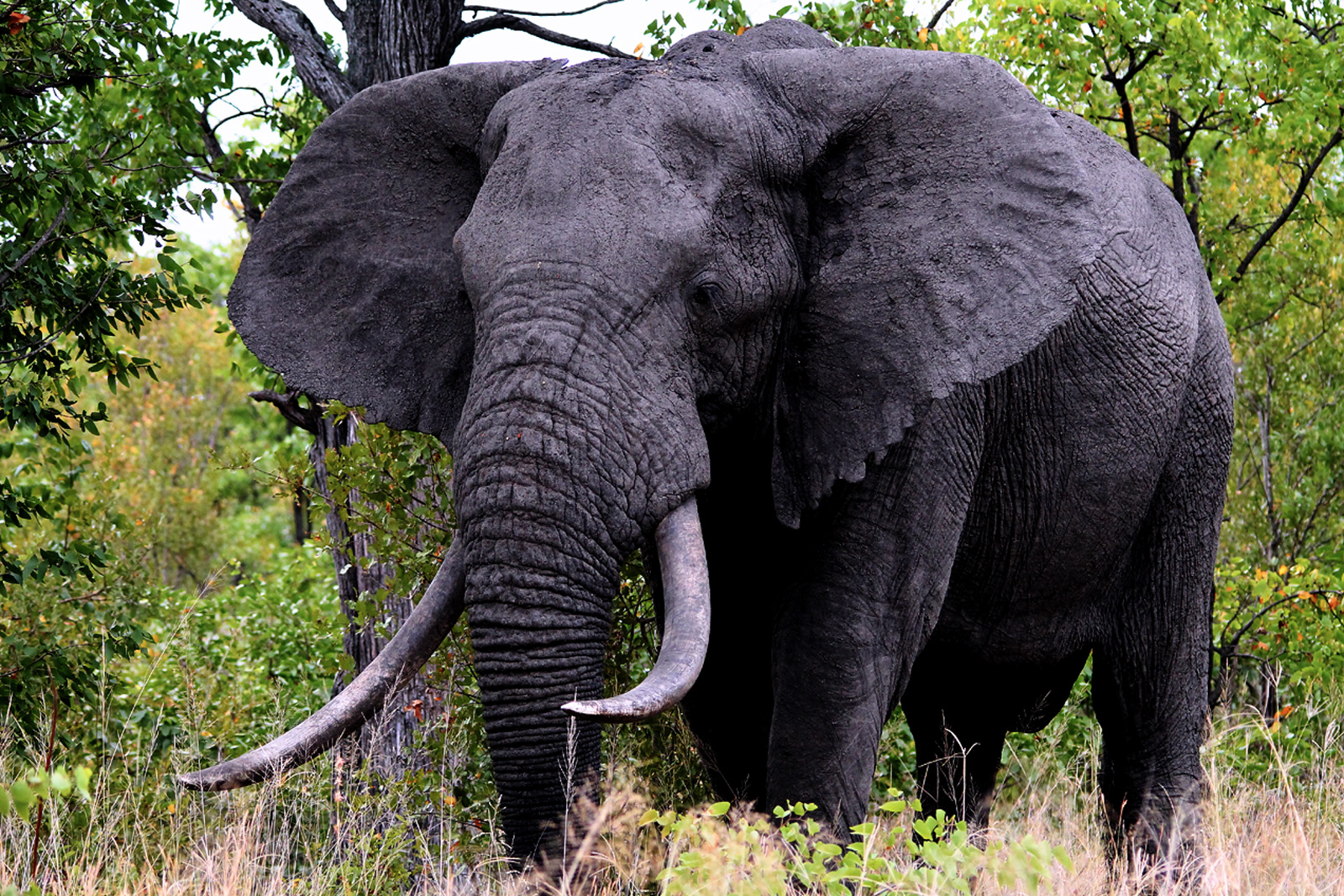
© Louis Bretenbach
Name: Vusopfa
Origin of name: Tsonga, meaning ‘untidy’. Vusopfa refers to the heavily torn and scraggly ears of this bull, making him easily identifiable.
Special features: This bull has very distinctive features, most notably a noticeably marked left ear with multiple u-shaped and v-shaped notches of varying sizes throughout the full length of the ear lobe. A small hole at the top of the lobe is also visible when fully displayed. The right lobe is less scraggly but also supports notable markings. A long, extended U-shaped notch is visible at the lower point of the lobe; an uneven W-shaped notch can be seen towards the middle of the lobe. From a frontal view, this elephant’s tusks are fairly wide apart and symmetrical – with both growing relatively straight and curving at the tip. From a side profile, the left tusk appears more curved than the right.
General: This bull was first sighted in December 2013. With no other submission at the time, it was decided to monitor him until additional sightings could confirm his status. Sightings since then were limited, with a few confirmed sightings in late 2014 and early 2015, increasing in 2016. Due to this, it was felt that there was sufficient evidence of his characteristics to name him and confirm his status as an emerging tusker.
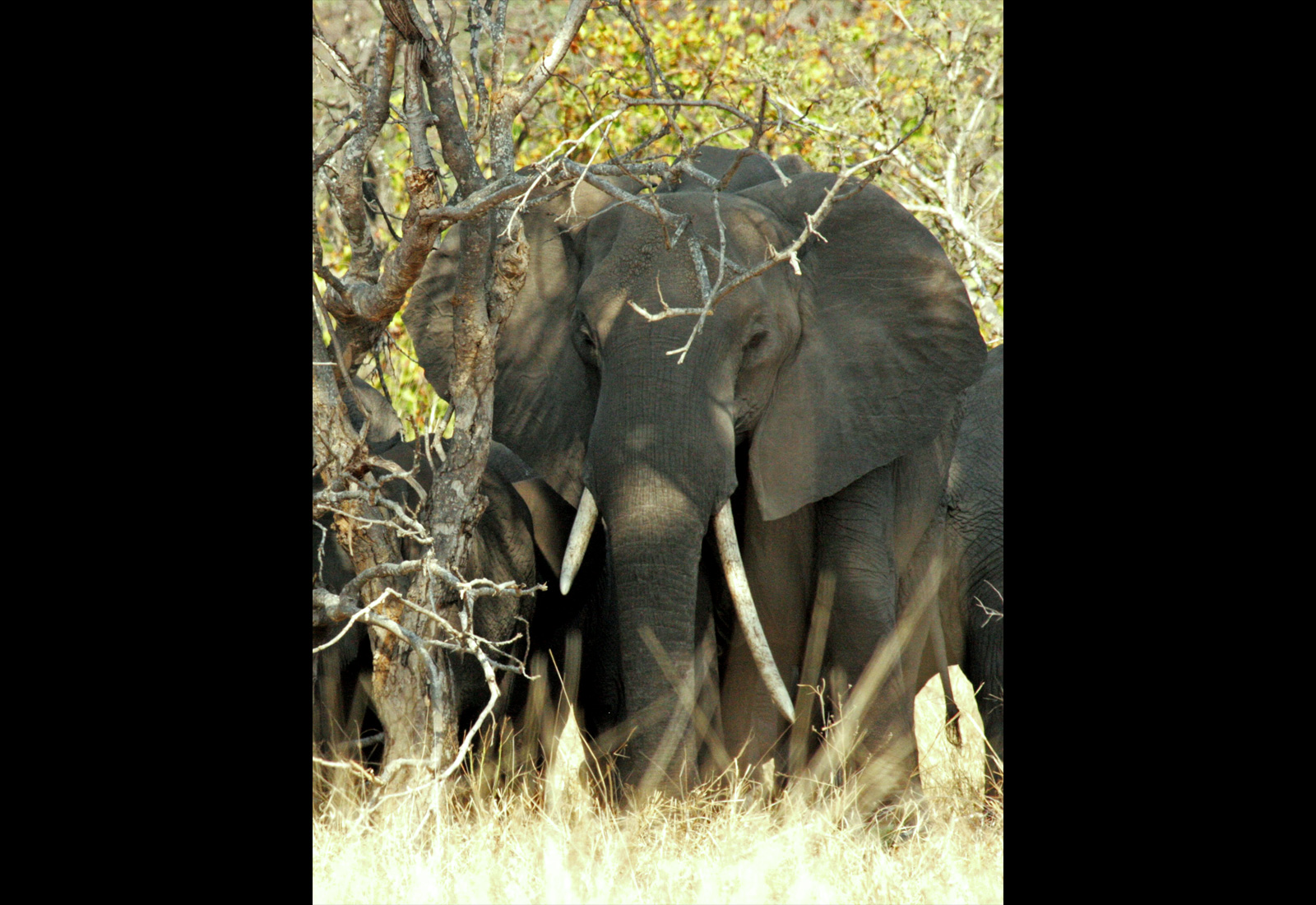
© Dr Ian Whyte
Name: N’wamisejani
Origin of name: N’wamisejani, meaning ‘clever or notorious woman’, refers specifically to this cow’s role of matriarch in her herd and the often revered manner in which the females in the herd will protect their offspring and siblings.
Special features: This cow’s most notable feature is its tusks. However, the longest tusk of N’wamisejani grows at an angle to the trunk, protruding slightly sideways. A shallow w-shaped notch is visible on the left ear lobe toward the upper middle, and a small v-shaped notch can be seen toward the middle of the right lobe.
General: This female was first sighted in 2014/2015. Given the unusual length of the tusks on this cow and an excellent photographic series showing the ear markings clearly, it was decided to name her.

© Tara-lynn Svensson
Name: N’watindlopfu
Origin of name: N’watindlopfu Spruit means ‘spruit of the elephants’ in Tsonga, and refers to the historic site where, in 1987, a striking and well-preserved panel of rock paintings depicting a group of four elephants was found on a small granite koppie. The name is a reference to the proof of the early existence of elephants in the Kruger National Park and, therefore, links to the great discovery that was this bull’s sudden appearance as a large tusker.
Special features: This bull has small u and v-shaped notches in his right ear throughout the lobe. A larger nick is present in the upper part of the same lobe. The left lobe has more distinct markings and, when fully open, an inverted wide u-shape is visible in the middle of the lobe. In the lower level of the lobe, small u and v-shaped notches are visible. N’watindlopfu has a very slightly thickened area of skin on the upper and middle regions of his trunk. There is a small, elongated growth on his upper front thigh that is visible from the left side. His tusks are what would be referred to as the ‘typical’ Kruger shape, with one very long tusk that is straighter than a slightly shorter and more curved tusk. The tusks curve at different levels. In his case, the right tusk is straighter and shows indication of an old chip off the tip.
General: This large bull had an interesting start in the tuskers project. A sighting on the 31st July 2014 initially created great confusion as to an ID on such an impressive bull due to an unclear location and similarities to other known bulls. Through back-tracking, it was established that he had been seen elsewhere to the other bulls and it was confirmed, as we had suspected, that we had a new tusker.
Further submissions by regular contributors in quick succession, with clear images of the left ear markings and tusks, confirmed this bull as a new tusker to the area. This bull seems to prefer being out of the limelight, which is perhaps why it took so long to find him.

© Joep Stevens
Name: Jubilala
Origin of name: Jub(a)ilala is a Siswati word, meaning ‘cut the ilala palm’, referring to the cutting of palms in Mozambique.
Special features: This cow has very unusual tusks. Not only does the right tusk carry a very significant length for a female elephant, but the tusk also grows at a complete angle to her body. The left tusk is much shorter than the right and has a break in it that occurred in 2011. Thankfully, not much length was lost with this break – only the initial sharply pointed curve has gone, and the end is more rounded. A small, coin-sized hole can be seen in the right lobe just above halfway; a very small, shallow U-shaped nick is also visible at the top of the lobe. The left ear has two small V-shaped notches: one on the lower section of the lobe and the other towards the lower middle of the lobe. Most notable with this cow, after her tusks, is the tennis ball-sized growth on the back of the front right leg in line with her body.
General: This cow was first sighted in December 2010. While she is a very impressive cow, due to the angle of the right tusk, it was felt that she would break this tusk easily, and there was a reluctance to name her if this was going to be the case. No further sightings of her were received until late 2011, so it could not be determined whether our suspicions were correct.
Sightings in December 2011 confirmed concerns, but to our surprise, the angled long tusk remained intact. However, she had broken the sharp curve of her left tusk. At this time, it was decided she should be named, and she has joined the ranks of the privileged few female tuskers in the large tusker status.
This cow seems to shy away from public areas and is very seldom seen, with an average of only one sighting per annum, but seeing her is worth the wait if she can be found.
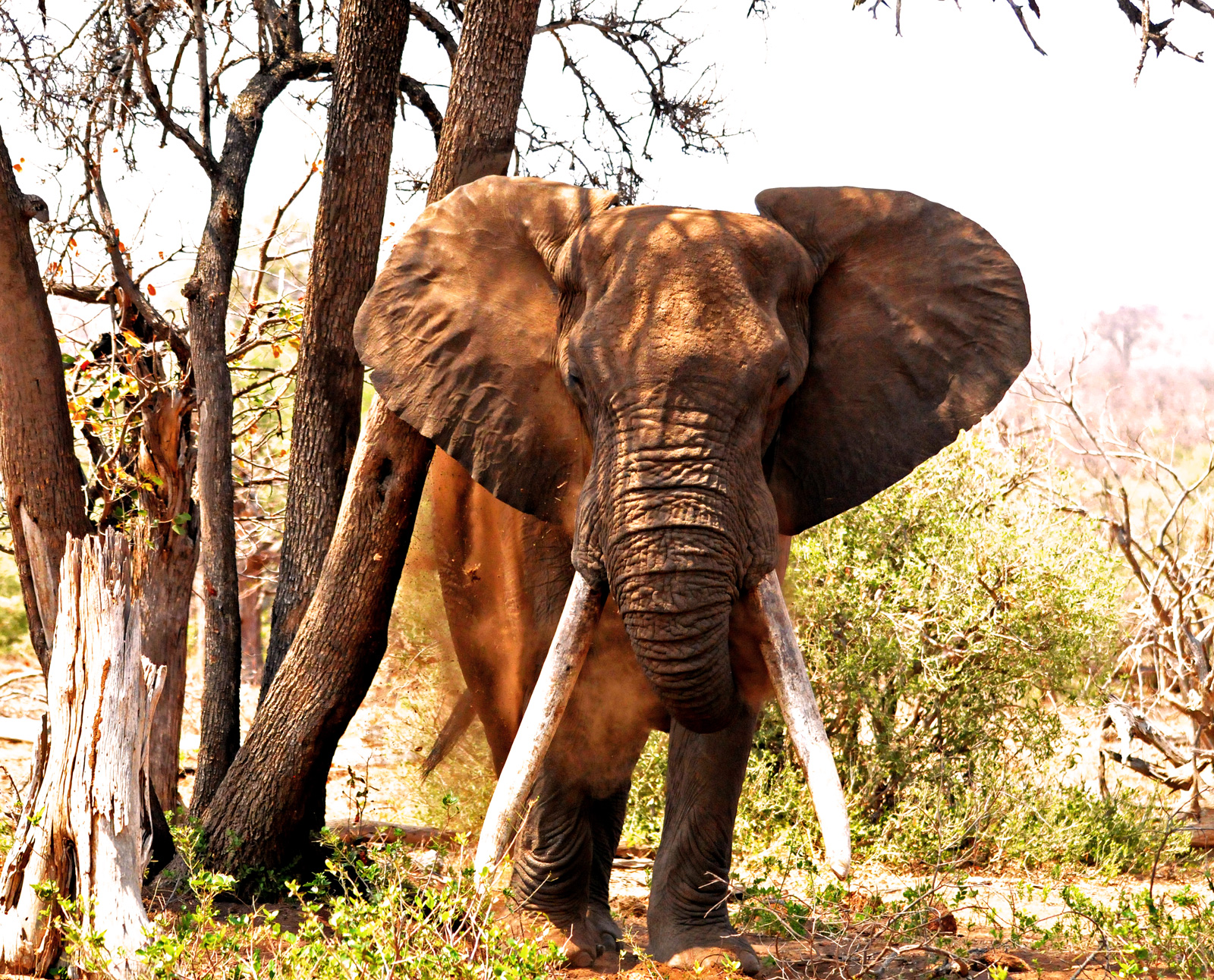
© Lorenzo Dallape
Name: Xindzulundzulu
Origin of name: Xindzulundzulu is Tsonga for ‘walking round and round in circles’. This is in reference to this bull’s very localised home range.
Special features: This bull has very distinct tusks widely splayed from a front view, long and straight, with tapered, pointed ends. The left tusk has a slightly rounded tip with a dip in the tip. Side profiles of the bull do show a shallow curve in the tusks. His ear lobes are fairly clean, with a small v-shaped notch in the right ear towards the top of the lobe. The left ear has two small notches mid-ear, creating a U-shape between these. Very small growths appear on the thigh of the rear left leg.
General: This bull was first sighted by Section Ranger Robert Bryden in 2009, at the time he was considered a worthwhile bull to monitor. The tusks lacked significant length, but given his young age, it was decided to continue to monitor him. Minimal sightings of him were submitted in the upcoming years, however, a growth spurt in his tusks in 2014 drew more attention to him and sightings of him increased considerably between 2014 – 2016. Given this significant growth and current length, it was decided to name him, confirming his status as a large tusker.
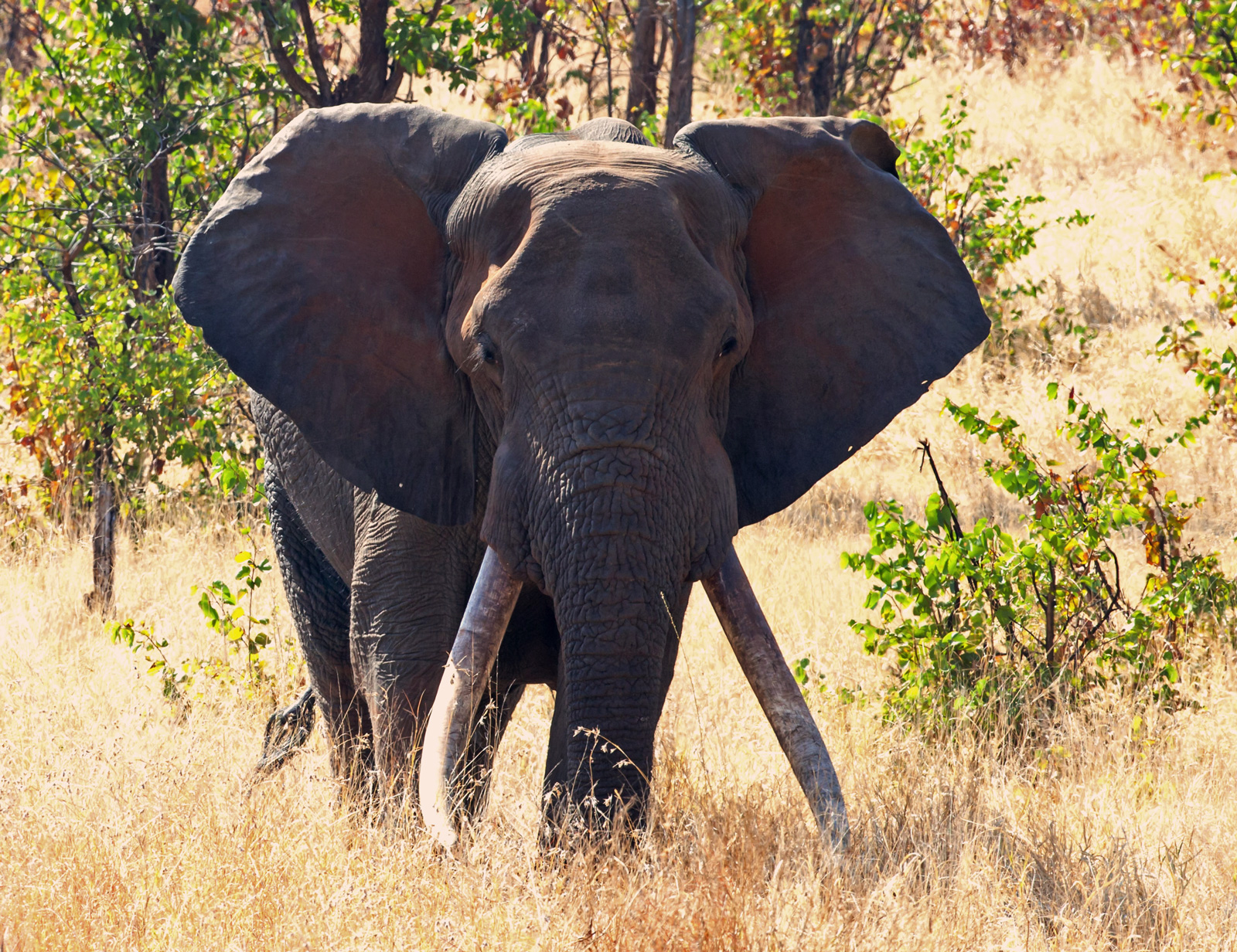
© Frans van Achterbergh
Name: Matlakusa
Origin of name: Matlakusa from ‘tlakusa’, is a Tsonga word meaning to ‘raise, lift up’.
Special features: This bull’s tusks closely resemble those of Xindzulundzulu, in that it is relatively symmetrical, straight and widely splayed, with a shallow curve from a side profile. The left ear holds the defining characteristics that separate these two bulls; there is a coin-sized hole in the tip of the lobe, as well as an area of damaged cartilage at the top, giving a large v-shaped ‘collapse’ in the ear. A very small u-shaped notch and two smaller holes are visible on the middle of the lobe but only at close inspection – and with the ears extended. The right earlobe had a smaller-sized hole towards the bottom of the lobe that has recently been torn and is now a U-shaped notch with a small hole towards the inner lobe above this. Other than this, the lobe is relatively clean-edged. A small protrusion of skin is visible on the trunk at the top, adjacent to the left tusk. Visible from a side profile is a growth on the left foreleg behind the leg, just above the joint.
General: Initial images of this bull were identified as Xindzulundzulu, due to the tusk shape. Later, in 2014, a full series of images submitted caused a little dilemma, as Xindzulundulu was known to only be local to a specific area and a new bull was suspected. Additional images regularly submitted showing his left and right side allowed the defining characteristics to be seen, and we were able to determine that these were, in fact, two separate bulls.
This revelation allowed two previous sightings in 2012, which were thought to be Xindzulundzulu, but could not be confirmed as the locations did not make sense – and defining characteristics in these images were unclear – to be accurately identified as Matlakusa. The receipt of the 2014 submission with clearer images would confirm these identifications. Several other images placed with Xindzulundzulu’s monitoring file could now also be separated out as being those of Matlakusa – and in 2015/2016, it was decided that sightings of him were sufficient to name the bull confirming his status.
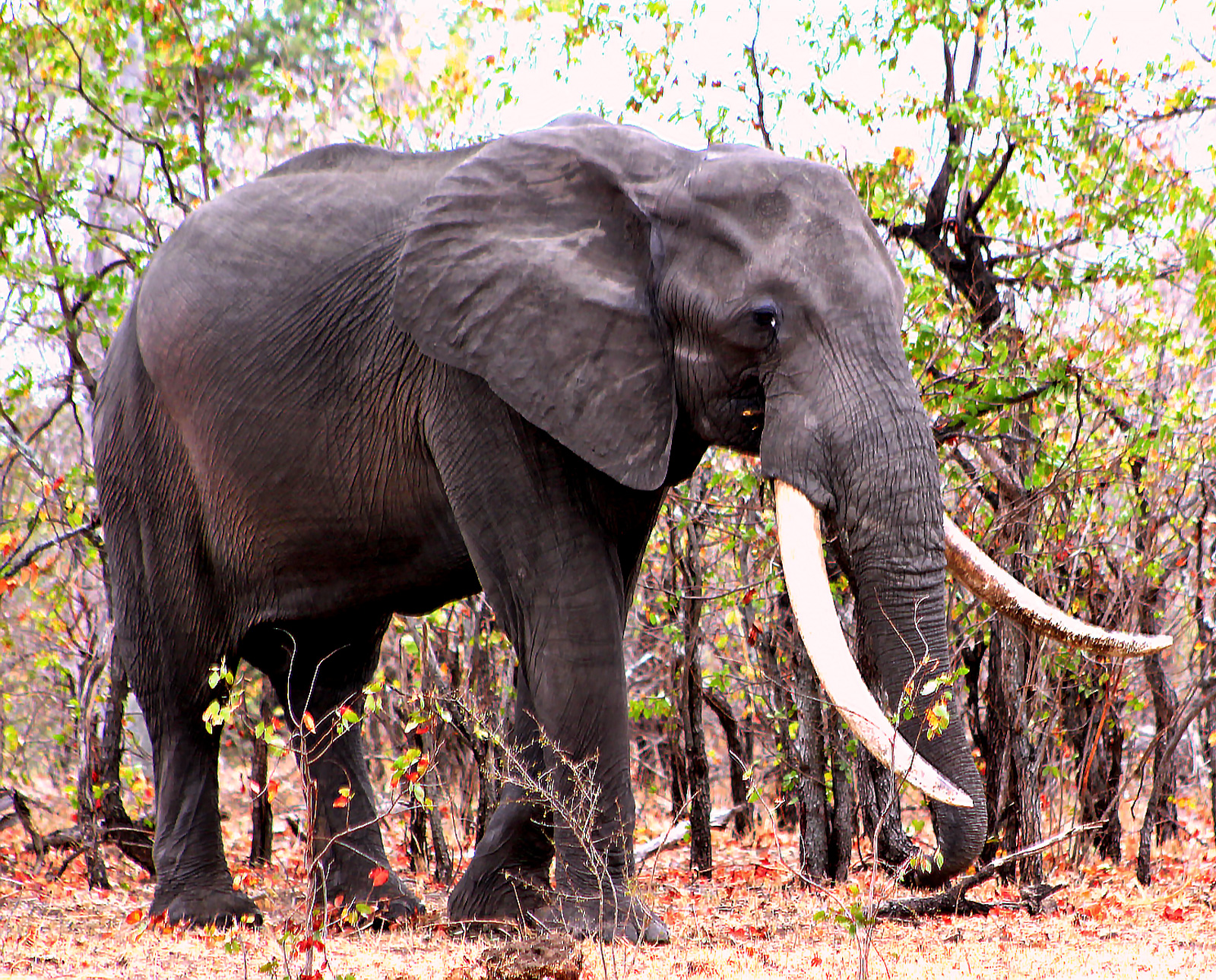
© Dawid Combrinck
Name: Ndlovane
Origin of name: Ndlovane, meaning ‘small elephant’, has been given to this elephant not for his size but for his young age and great potential to develop into a future great tusker.
Special features: On the left ear lobe, towards the bottom, there are several small nodules and holes in the lobe, with a few additional nicks and nodules further up the ear. The right ear lobe has a few more distinctive markings: a small hole is visible towards the bottom and middle of the lobe. Towards the top of the lobe is an inverted U-shaped piece of the lobe caused by two shallow U-shaped indentations in the lobe. The tusks of this bull are irregularly shaped and very similar in shape to those of Ngonyama – for whom this bull is often mistaken. The right tusk is straighter and longer in appearance than the left tusk, which is curved forward – giving the illusion that it is the shorter tusk. Side profiles of the tusks provide the appearance of them being very close together, much like Ngonyama. However, from a front view, they are more splayed. This bull’s tusks are not as splayed as Ngonyama, but the side and front profiles are similar enough to confuse. A slightly less notable characteristic is his remarkable lack of tail hair.
General: The first clear series of images showing this bull’s identifying features and confirming his status as a new tusker was submitted by a park staff member in 2014. This series allowed for the linking of other sightings in 2012 and 2013. These previous submissions were considered valuable enough to open monitoring files, but due to the angle of the bull or the image quality, the defining characteristics could not be fully determined. This bull is often mistaken for Ngonyama, as their tusk shape is very similar. However, the distinctive hole in the left ear lobe, thickening on the trunk, as well as growths on the rear are not visible in this bull – and as previously indicated, the tusks on this bull are closer together. Sightings of this bull increased dramatically in 2014 – 2016, leading to the decision to name him and confirm his status as an emerging tusker.
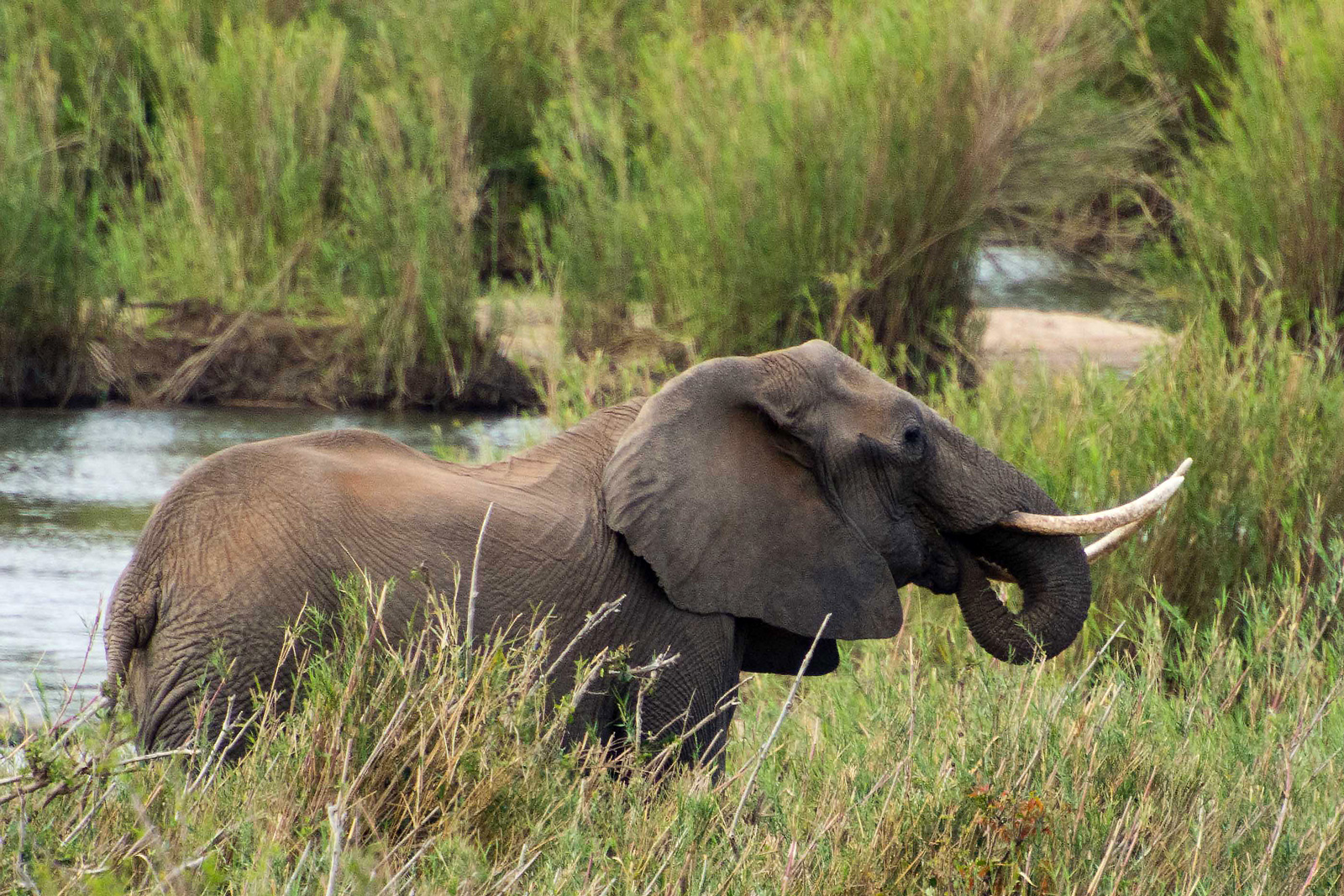
© Manuel Krog
Name: N’waMndlovu
Origin of name: N’waMndlovu is a Tsonga word, meaning ‘daughter of the elephant’. It refers to this cow’s role within the breeding herd. The images received would indicate that she is not the matriarch but one of the more senior cows in the herd structure, possibly a potential successor to the matriarch.
Special features: Long, thin and curved tusks, with the right tusk having a previous break and shorter than the left, with a more rounded end. The ears of this cow are relatively clean; there are several small, w-shaped notches towards the top of the right ear lobe, the lower one being the largest of the series. A wide, W-shaped notch is noticeable on the top of the left ear lobe when the ears are fully displayed.
General: This cow was a relatively new arrival to the tusker project, and was not monitored long after her first sighting in April 2014. Due to the exceptional tusk length for a female elephant, it was decided to name her immediately as sufficient information was available.

© Tara-lynn Svensson
Name: Botsotso
Origin of name: Botsotso is a Tsonga word that refers to a particular style of jeans that were worn in the olden days – it is a direct reference to the large and prominent folds of skin on the rear of this bull, making them one of his key identification characteristics.
Special features: Once again, we have a bull with a similar tusk shape to Matlakusa and Xindzulundzulu. Although, this bull’s straight and symmetrical ivory is not as widely splayed, and shows an inward curve of both tusks towards the bottom. His most notable ear markings are found on his left ear – at the bottom of the lobe there is a deep, u-shaped tear in the tip. Further up towards the middle of the lobe, there is a small, v-shaped notch. In the outer lobe, above this, towards the top of the lobe there is a deeper w-shaped notch – both of these are only visible in high-resolution images. In earlier images, there are signs that the right tusk experienced a small break, which has subsequently smoothed over, and the re-growth has allowed the tusks to remain reasonably symmetrical. The trunk does offer a few key identification characteristics – at the lip line on the right tusk there is a scarring growth that looks like a tennis or golf ball between the tusk and trunk.
General: This is another bull that started out being monitored slowly, as there was only one submission of him in 2010. A further single submission in 2011 confirmed the identifying characteristics, however, it was still felt that with limited submissions, he should continue to be monitored. From 2014 to 2016, sightings of this bull increased dramatically, and it was then decided to confirm his status as an emerging tusker by naming him.
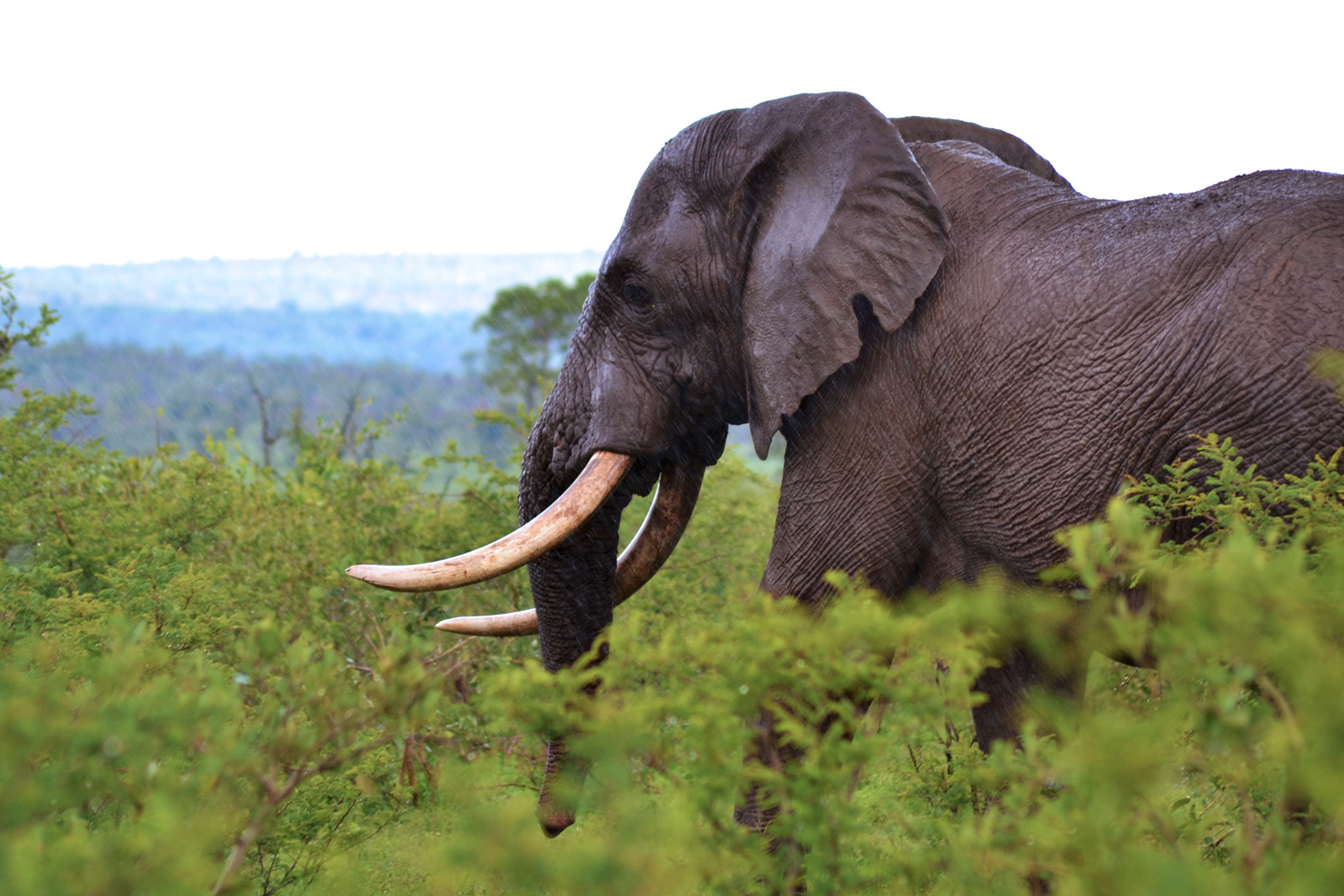
© Tara-lynn Svensson
Name: Ngwenya
Origin of name: Ngwenya, meaning ‘crocodile’ in Tsonga.
Special features: Ngwenya has a very noticeable, deep, U-shaped notch in his left ear lobe. Less notable on the same lobe are an inverted v-shaped notch below the large notch and a v-shaped nick below this. A small coin-sized hole is visible above the inverted v-shape towards the middle of the lobe. His right ear lobe does not have any noticeable markings, a very small v-shaped notch is visible towards the middle of the lobe, as well as a very shallow long u-shaped notch towards the top of the lobe. Ngwenya’s tusks are very curved, and from a direct side profile, the left tusk appears more curved and higher than the right tusk. A recent break (2016) in the left tusk has given the tusks a more even appearance.
General: This bull was first sighted in 2013. There was limited footage of this bull at this time, with only a second sighting in December 2013. It was decided to monitor him until more submissions were made. A dramatic increase in sightings in late 2014 – 2016 cemented his status as a large tusker, and the decision was taken to name him.
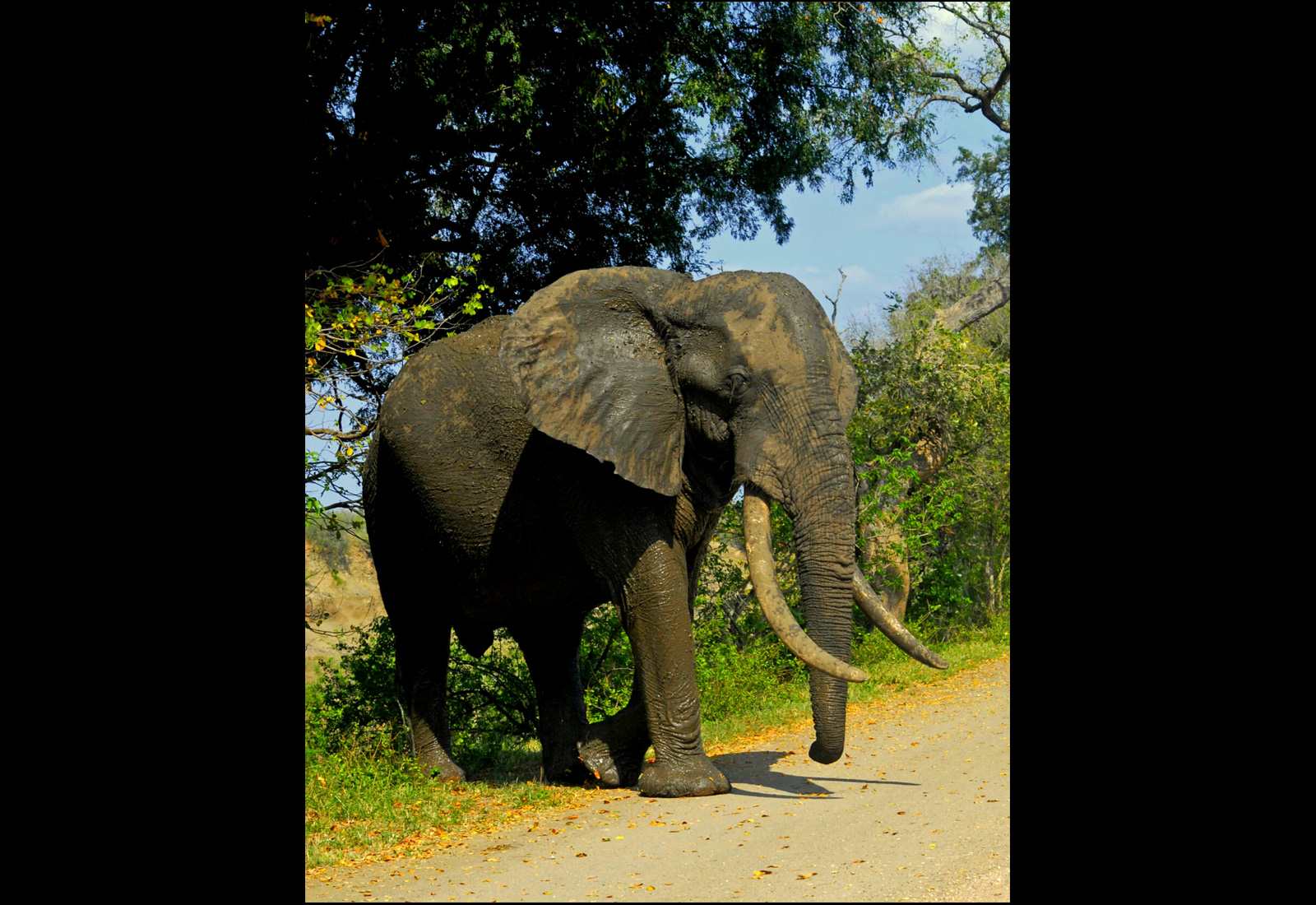
© Deborah Gage
Name: Hahlwa
Origin of name: The name Hahlwa is a Tsonga word meaning ‘twin’. The tusks and the ear markings of this bull resemble, almost identically, those of Masasana – and in many images, he would seem to be his twin.
Special features: The right tusk of this bull is slightly longer and straighter than the left tusk, which has a small curve at the tip. The tusks, like Masasana, are close together and from a side profile appear straight. The left ear has a w-shaped notch that has a piece of skin hanging in the middle, forming the w-shape towards the middle of the ear – very similar to Masasana. The right ear is the biggest differing identification mark between the bulls, where a wide square notch is visible on his lower right lobe. An oval, tennis ball-sized growth is also visible on his left front leg, close to the top, but this is not always prominently seen in images. The thickening on the trunk closely resembles the thick line markings on Masasana, although with a small variation in shape towards the centre of the trunk and top left, close to the ivory lip.
General: This bull caused considerable confusion with his initial sightings in October 2015, primarily due to the majority of his identification markings being virtually identical to Masasana – but he was sighted in an area considered unusual for Masasana, who until recently had remained local to a more specific area elsewhere. Despite scrutiny of all his key identifying features by several experts, confirmation of his identity could not be offered. The ‘new’ notch in the right ear left questions as to whether Masasana was extending his home range due to the dry conditions prevailing in the KNP. At the time, this was a distinct possibility as many known bulls had changed their ‘traditional’ movements due to water shortages.
A committed answer to these questions could not be made until confirmed sightings of Masasana were received, as the bulls were just too similar. Fortunately, the wait was not long, and sightings of the ‘twin bull’ in late January 2016 and Masasana in another location in March 2016 confirmed that these were two different bulls.
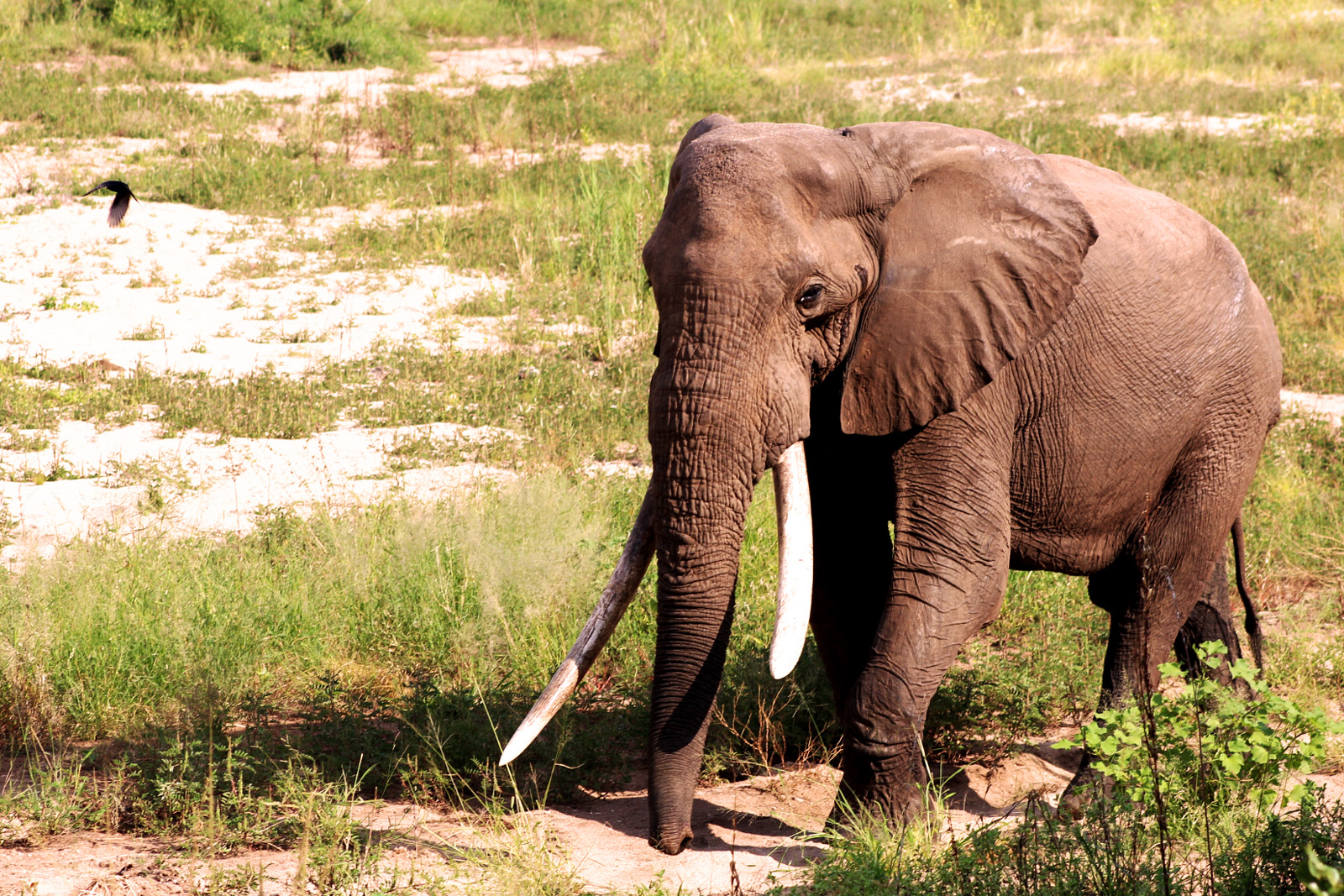
© Colin Rowles
Name: N’wendlamuharhi
Origin of name: N’wendlamuharhi is Shangaan for ‘sand river’, meaning that ‘the river that is fierce when in flood’.
Special features: Most notable on this bull are his tusks. His left tusk suffered a dramatic break many years back, and while there has been substantial growth of the tusk since then, there is a marked difference in length between the two tusks. The left tusk break has smoothed over time and has developed quite a prominent point to it. There are very few notable ear markings on this bull, aside from a small v-shaped nick visible in the left lobe towards the top, and small u-shaped marks towards the top of the right ear lobe. Visible from a left-side profile is a cluster of small growths on the front of the left foreleg, fairly high up the leg. The ear lobe often obscures these in frontal images.
General: This bull was first noted by retired Section Ranger Johann Oelofse in 2010, shortly after the death of the similar-looking Mandhevhu. As these images did not identify any defining characteristics, it was decided to monitor him. The second submission in 2011 confirmed this bull’s status as a tusker, but it was decided to continue to monitor him to determine if there would be any continued growth.
Submissions of this bull increased dramatically at the end of 2013 and throughout 2014 – 2016. All submissions show considerable growth in the broken tusk, therefore the decision was made to name the bull confirming his status as a large tusker.
The images and information for this gallery have been provided with thanks to the dedicated people at Kruger National Park who work on this important conservation project.
If you would like to submit your photos to the project, please email your submissions to tuskers@sanparks.org.
 Find out about the Greater Kruger for your next African safari. You can choose a ready-made safari or ask us to build one just for you.
Find out about the Greater Kruger for your next African safari. You can choose a ready-made safari or ask us to build one just for you.
To comment on this story: Login (or sign up) to our app here - it's a troll-free safe place 🙂.![]()




